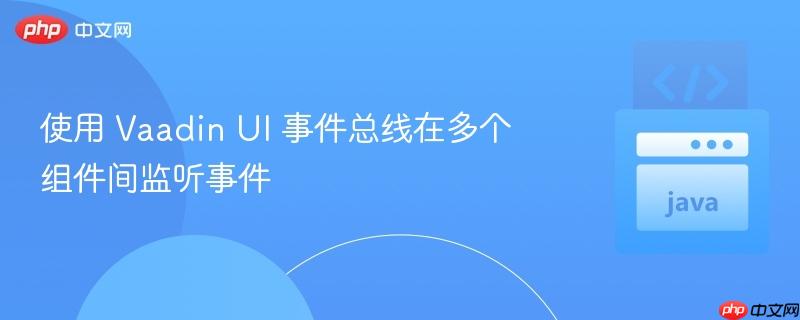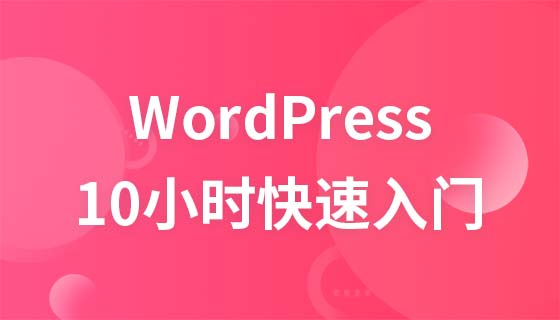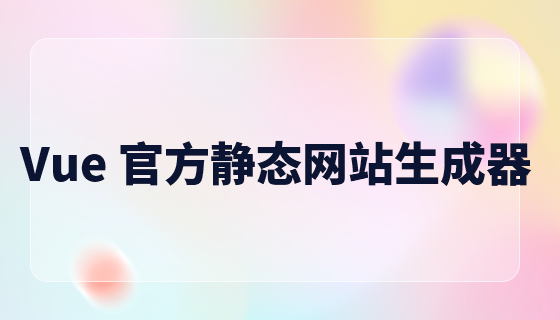
本文介绍了如何在 Vaadin 应用中跨多个组件监听事件。通过使用 UI 事件总线,可以在不同的组件之间传递和处理事件,实现组件间的解耦和灵活通信。文章将提供示例代码,演示如何在主视图中监听来自对话框组件的事件,并在事件发生时执行相应的操作。
在 Vaadin 应用开发中,组件间的通信是一个常见的需求。当需要在不同的组件之间传递事件并执行相应的操作时,可以使用 Vaadin 提供的 UI 事件总线。UI 事件总线允许组件发布事件,而其他组件可以监听这些事件并做出响应,从而实现组件间的解耦和灵活通信。
使用 UI 事件总线
要使用 UI 事件总线,需要在主视图中监听事件,并在需要触发事件的组件中使用 ComponentUtil.fireEvent() 方法。
示例代码
以下示例演示了如何在 MainView 中监听来自 CustomDialog 组件的 ComponentCloseEvent 事件。
首先,定义 ComponentCloseEvent 事件:
import com.vaadin.flow.component.ComponentEvent;
import com.vaadin.flow.component.Component;
import com.vaadin.flow.component.DomEvent;
import com.vaadin.flow.component.EventData;
import com.vaadin.flow.component.ComponentEventListener;
public class ComponentCloseEvent extends ComponentEvent<CustomDialog> {
public ComponentCloseEvent(CustomDialog source, boolean fromClient) {
super(source, fromClient);
}
}然后,在 MainView 的 onAttach() 方法中,将监听器添加到 UI 事件总线:
import com.vaadin.flow.component.Component;
import com.vaadin.flow.component.UI;
import com.vaadin.flow.component.button.Button;
import com.vaadin.flow.component.dialog.Dialog;
import com.vaadin.flow.component.orderedlayout.VerticalLayout;
import com.vaadin.flow.router.Route;
import com.vaadin.flow.component.ComponentUtil;
import com.vaadin.flow.server.VaadinSession;
import com.vaadin.flow.shared.Registration;
import com.vaadin.flow.component.AttachEvent;
@Route("")
public class MainView extends VerticalLayout {
private CustomDialog customDialog;
public MainView() {
customDialog = new CustomDialog();
add(customDialog);
}
@Override
protected void onAttach(AttachEvent attachEvent) {
UI ui = attachEvent.getUI();
ui.getSession().setAttribute("mainView", this);
Registration registration = ui.addDetachListener(detachEvent -> {
ui.getSession().removeAttribute("mainView");
});
ui.getSession().setAttribute("registration", registration);
ui.addClickListener(e -> {
System.out.println("UI Clicked");
});
addListener(ComponentCloseEvent.class, e -> {
System.out.println("I listened to the event!");
Button openDialogButton = new Button("Open Dialog");
openDialogButton.addClickListener(event -> {
customDialog.open();
});
add(openDialogButton);
});
}
public <T extends ComponentEvent<?>> Registration addListener(Class<T> eventType,
ComponentEventListener<T> listener) {
return ComponentUtil.addListener(UI.getCurrent(), eventType, (ComponentEventListener) listener);
}
}接下来,在 CustomDialog 组件中,使用 ComponentUtil.fireEvent() 方法触发事件:
import com.vaadin.flow.component.Component;
import com.vaadin.flow.component.ComponentUtil;
import com.vaadin.flow.component.button.Button;
import com.vaadin.flow.component.dialog.Dialog;
public class CustomDialog extends Dialog {
public CustomDialog() {
setHeaderTitle("Custom Dialog");
add("This is a custom dialog.");
add(createCloseButton());
setCloseOnEsc(false);
setCloseOnOutsideClick(false);
}
private Button createCloseButton() {
return new Button("Close", e -> {
ComponentUtil.fireEvent(UI.getCurrent(), new ComponentCloseEvent(this, true));
close();
});
}
@Override
public void open() {
super.open();
}
}在这个例子中,当 CustomDialog 组件的关闭按钮被点击时,会触发 ComponentCloseEvent 事件。MainView 组件监听这个事件,并在事件发生时打印一条消息。
注意事项
总结
通过使用 Vaadin UI 事件总线,可以方便地在多个组件之间监听事件,实现组件间的解耦和灵活通信。这种方法可以用于各种场景,例如在主视图中监听来自对话框组件的事件,并在事件发生时执行相应的操作。
以上就是使用 Vaadin UI 事件总线在多个组件间监听事件的详细内容,更多请关注php中文网其它相关文章!

每个人都需要一台速度更快、更稳定的 PC。随着时间的推移,垃圾文件、旧注册表数据和不必要的后台进程会占用资源并降低性能。幸运的是,许多工具可以让 Windows 保持平稳运行。




Copyright 2014-2025 https://www.php.cn/ All Rights Reserved | php.cn | 湘ICP备2023035733号